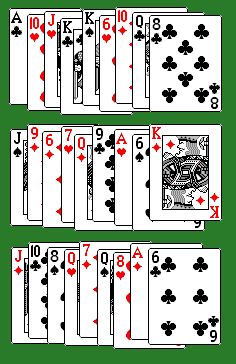Copyright
- Cards and deal
- From a 36-card

Three rows of nine when three play pack (AKQJ109876 in each suit) deal three rows of 9 cards face up if three play, or of 12 cards if four, overlapping one another so that all are identifiable. If five play, deal three rows of nine from the full 52-card pack. If three or five play, stack the undealt cards aside, face down. They will not be used. - Object
- To collect a hand of nine cards exhibiting as many card combinations as possible. Its scoring value will be
calculated by multiplying three factors together:
- Flush: the number of cards in your longest suit.
- Sequence: the number of cards in your longest numerical sequence (ignoring suits).
- Sets: the number of cards belonging to sets of three or four of the same rank.
- Play
- Starting with dealer's left-hand neighbour, you each in turn draw one, two or three cards from the top (uncovered) end of any of the face-up rows. If you draw one, it can come from the end of any row; if two, they can be both from one row or one from each of two rows; and if three, they can be one from any three rows, or three from any one row, or two from one and one from another. Hold your cards so that no one can see what you have collected, and stop drawing when your hand contains nine cards.
- Score
- When all cards have been drawn you each in turn reveal your final nine-card hand and score for it as described above, but
note these further details:
- Flush: if you have two equally long suits, only one of them counts.
- Sequence: Ace counts high only (A-K-Q..., not A-6-7) unless all 52 cards are used, when A-2-3 is allowable. Only one sequence counts. If you have no sequence longer than two cards your multiplier is 2; and if you haven't even a two-card sequence it is 1.
- Set: You score for all the sets you hold. If you haven't any three or four of a kind but do have one or more pairs, your multiplier is 2 (in total, not 2 per pair); and if you haven't even a pair, it is 1.
- Game
- Play as many deals as there are players, with each dealing in turn from the full pack, and keep a running score of your totals. The winner is the player with the highest overall total. Alternatively, play up to a target score of 147. (Why? See "interesting score", below.)
- Example
- From the illustrated example (above), the cards taken and scores made were:
Annie:
 A-Q-9-8-6
A-Q-9-8-6
 A
A
 A-Q
A-Q
 6, making 5x2x6=60
6, making 5x2x6=60
Benny: A-K-10-9-7-6
A-K-10-9-7-6
 K
K
 7
7
 K, making 6x2x3=36
K, making 6x2x3=36
Connie: Q-J-10-8-6
Q-J-10-8-6
 J-6
J-6
 J
J
 10, making 5x3x3=45
10, making 5x3x3=45
- Optional extra
- If three play, there will be nine cards left undealt. Calculate their value as if they were a player's final hand. (In the example above it will be 30). Anyone who scores less than this has their score for this deal annulled.
- A note on play
- As flushes are easy to get, it is important to boost your score by taking at least three cards in sequence and at least one set of three alike.
- Interesting score
- As a matter of interest, the highest possible score would be for 7 cards in suit and sequence and a set of 3, making 7x7x3=147. That's the same as the highest break in snooker! (The lowest is 12, for a flush of 3 and no sequence or set of more than 2 each, making 3x2x2 in all.)